 |
 |
 |
 |
 |
 |
 |
 |
 |
 |
 |
 |
 |
 |
 |
 |
 |
 |
 |
 |
 |
 |
 |
 |
 |
 |
 |
 |
 |
 |
 |
 |
 |
 |
 |
 |
 |
 |
 |
 |
 |
 |
 |
 |
 |
 |
 |
 |
 |
 |
 |
 |
 |
 |
 |
 |
 |
 |
 |
 |
 |
 |
 |
 |
 |
 |
 |
 |
 |
 |
 |
 |
 |
|
|
ROCCAMORICE |
|
|
|
(Pg. 19) |
|
|
|
La Rocca Pg.
13 (San Donato Church)
La Rocca Pg.
14 (people / places)
La Rocca Pg.
15 (people / places)
La Rocca Pg.
16 (people / places)
La Rocca Pg.
17 (places to stay / eat)
La Rocca Pg.
18 (Asphalt Mines)
La Rocca Pg.
19 (Asphalt Mines)
La Rocca Pg.
20 (Churches)
La Rocca Pg.
21 (Churches)
La Rocca Pg.
22 (people/places)
La Rocca Pg.
23 (people/places)
La Rocca Pg.
24 (people/places) |
|
|
La Rocca
Pg. 1 (history/photos)
La Rocca
Pg. 2 (Santo Spirito)
La Rocca
Pg. 3 (San Bartolomeo)
La Rocca
Pg. 4 (photos)
La Rocca
Pg. 5 (photos)
La Rocca
Pg. 6 (photos)
La Rocca
Pg. 7 (festa)
La Rocca
Pg. 8 (the old ways)
La Rocca
Pg. 9 (the old ways)
La Rocca
Pg. 10 ("Lu
Sand'Andune")
La Rocca
Pg. 11 (La Rocca's
Sand'Andune)
La Rocca
Pg. 12 (Don Donato
Bianco) |
|
|
|
|
|
 |
|
|
|
ASPHALT MINES
MINIERE
D'ASFALTO |
|
|
|
Lu Pulone- cont'd. |
|
|
|
The mine at Lu Pulone was also
called "settantacinque" because it was 75 metres below the ground level in
the area . Another mining area was called "CentCinque", being 105
metres below ground level . |
|
|
|
 |
|
|
|
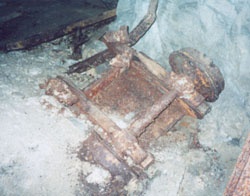 |
|
|
|
|
|
Old wagons (le carretele) still inside the mine
which were used to carry the rocks. |
|
|
|
|
|
 |
|
|
 |
|
|
|
|
|
|
Partial skeleton of an animal that died inside the
mine long ago. It looked like a fox (volpe). |
|
|
|
|
|
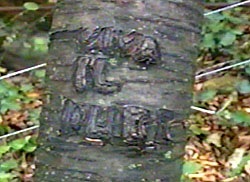 |
|
|
|
|
Large chain still lying on the floor inside the
mine.
|
|
|
|
|
|
 |
|
|
|
|
|
|
"Viva Il Duce" carved in a tree beside the
entrance to Lu Pulone. |
|
|
|
|
|
 |
|
|
An old entrance to the abandoned mine tunnel. From
here the track went down to Scafa. |
|
|
|
|
|
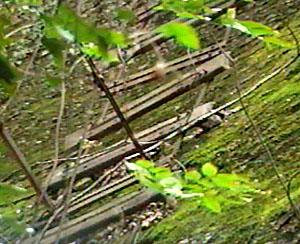 |
|
|
|
|
|
|
Remains of an old wall or bridge in the bottom of
the ravine below the mine entrance. Not sure if it was a bridge or made to
hold up the walls so there wouldn't be a cave-in. |
|
|
|
|
|
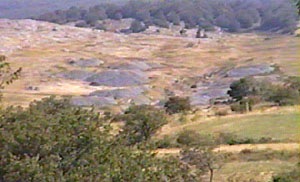 |
|
|
Remains of the old foot bridge (la Passarella)
from Roccamorice to Abbateggio. There was also a long foot bridge that
went from Lu Pulone to Lettomanoppello. This was the old way to go to
LuLett when the ravines were full of water and no modern roads had
yet been built. |
|
|
|
|
|
|
Large piles of the "cooked" rocks dot the
landscape above Roccamorice. In the 1940s this rock was gathered by men
and women (young and old alike). Then it was cooked in large ovens in
order to extract the "benzina" - petroleum. |
|
|
|
|
|
During WWII the army installed at Acquafredda
special ovens designed to heat the rocks in order to distill "benzina"-
petroleum . At that time they used the military and Prisoners of war as
well as local people to work there . The vast construction was
dismantled at the end of the war . |
|
|
|
 |
|
|
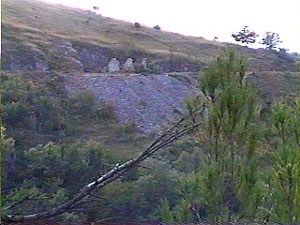 |
|
|
|
|
|
|
Ruins below "Codacchio" where rocks were dug and
heated to extract petroleum products during the 1940s. The name of this
area is "Pundone de Futigne". This area is located directly across from a
small picnic area on the Lettomanoppello side of the ravine where a path
which leads down to the Grotto of San Angelo . |
|
|
|
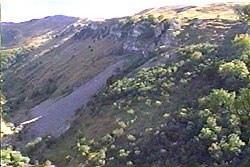 |
|
|
|
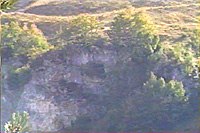 |
|
|
|
|
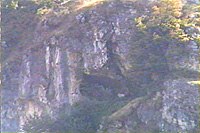 |
|
|
|
|
|
|
Waste rocks which were left over after the mining
process and then dumped into the ravine. |
|
|
|
Mine openings which are still visible, just above
the mine tailings which are seen in the left picture . |
|
|
|
|
|
In the late 1950s most mining activities
ceased leaving a few areas open until the mid 1960's. Many familes
emigrated to Canada and the US at about the same time in order to find
work.
Today, the mines remain only a memory -
for some pleasant, for others painful. |
|
|
|
 |
|
|
|
Lu
Lette | La
Rocca | The
Area | Other Towns
| "Stories"
Lu
Lette Surnames | La Rocca
Surnames | Maps |
Family
Nicknames
Organizations &
Events | Scrapbook |
Genealogy
Help | Links
Sign
Our Guestbook | Home |
View Our
Guestbook
*DOWNLOAD LU LETTE AND
LA ROCCA SONGS*
*DIALECT
VERSE ABOUT A LETTESE AND A ROCCOLANO*
|
|
|
|
 |
|
 |
|
|
|
La Rocca Pg.
18 |
|
La Rocca Pg.
20 |
|













